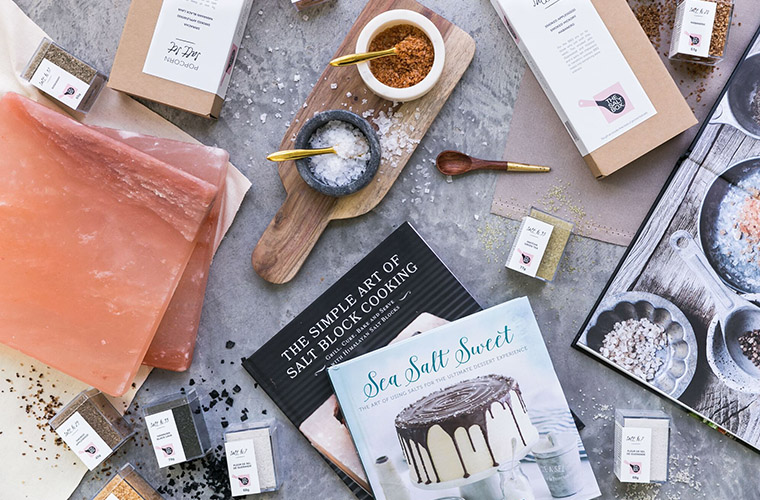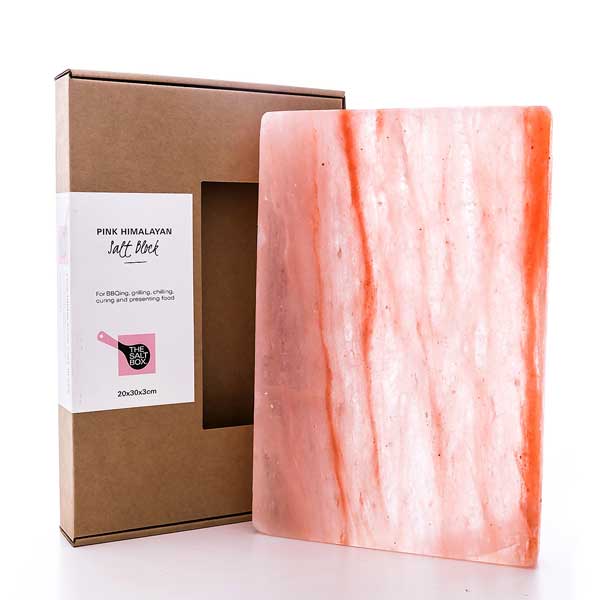A Total Guide to Himalayan Salt Blocks: Benefits, Uses, Cooking Tips, Cleaning, and Storing
Posted by The Salt Box on 5th Nov 2019
Salt block cooking may be a new concept for some people, but it is definitely one to explore. Himalayan salt blocks have tons of benefits. Aside from them being very attractive - who isn’t enamoured by that beautiful blushed pink hue of salt that’s been kissed by the Himalayan sun? - cooking on a salt block has a range of benefits over more traditional methods.

We take a look at the benefits of Himalayan pink salt, how to use a Himalayan salt block and how to cook with one, and some tips for using, cleaning and storing your block.
What Are Himalayan Salt Blocks?
As their name suggests, Himalayan salt blocks are large slabs of Himalayan pink salt, or should I say rock, that have been carved specifically for use in cooking. They come in a range of sizes and serve as a unique way to cook, cure, chill and present food.
Many regard Himalayan pink salt as the King of Salts. It is an unrefined, unprocessed raw mineral mined from caves formed 250 million years ago in the Himalayan mountain range. The salt from these mines has experienced tremendous pressure over the years, and for this reason is extremely pure.
While chemically similar to standard table salt (sodium chloride, or NaCl), Himalayan pink salt is packed with trace minerals like potassium, magnesium and calcium, which are responsible for its gorgeous pink hue. Salt blocks can range in colour (there are changes of colour in each salt block) and is due to various trace minerals trapped in the salt. What may appear as cracks are just aesthetic and has no bearing on the use or longevity of the salt block.
Salt blocks also impart an intriguing flavour, and a range of perks that make it highly sought after.
What Are The Health Benefits of Eating Himalayan Pink Salt?
There are a number of reasons that Himalayan pink salt is widely regarded as being superior to standard table salt, and many of these are health-related.
What Are The Benefits of Cooking With Himalayan Salt Blocks?
More and more people are reaching for salt blocks in the kitchen, and for good reason. Not only do they look beautiful (and are sure to impress your dinner guests), cooking with a Himalayan salt block has a range of benefits.

What Are Himalayan Salt Blocks Used For?
Himalayan salt blocks can be used a number of different ways in the kitchen - you’ll be blown away by their versatility.
Cooking - Salt blocks can be used for cooking just about anything: meats, seafood, vegetables, baking, pizzas, eggs. You can use them indoors on your stovetop or oven, or outside on the grill or BBQ.
Chilling - Try resting or chilling foods in the fridge on a salt block to give them a mild, delicious salty flavour.
Curing – Salt blocks are brilliant for either partially or fully curing meat or fish. The salinity of the block will begin working when food comes in contact with a block, meaning you can make everything from gravlax (slightly cured salmon) to beef jerky.
Presenting - How about using a salt block to present a delicious serving of sashimi, or a charcuterie plate, or even a scoop or two of ice-cream?
How Do You Use a Himalayan Salt Block?
Make Sure You Know the Top and the Bottom
It is important to always cook on the same side of the block. This will ensure the same side will always be heated, which will discourage cracking and fissures, ensuring you and your block a long and fruitful relationship together.
How To Temper Your Block
The first couple of times you use your block, heat it slowly. This will ensure it retains its strength for longer and will improve it as a cooking surface - a process known as tempering. It is very simple and usually involves placing it in the oven then gradually increasing the temperature in 15 minute increments until it reaches very high heat (usually 500 degrees). You then allow the block to cool to room temperature. Make sure you read your block’s specific instructions for tempering.
How To Cook on Your Block
Here are a few tips for cooking on your block:
How To Clean and Store a Himalayan Salt Block?
When it comes to Himalayan salt blocks, cleaning is a very delicate process. First and foremost, don’t use soap, and don’t put it in your dishwasher!
Allow it to cool first, then wipe it down softly with a moist sponge (not soaking wet one), scrub with a brush or scourer if need be, and pat dry immediately. Then allow to air-dry for as long as needed. The antimicrobial properties of salt keep the block clean with no need for soap. Keep the block as dry as possible and never submerge in water. You don’t want the salt to dissolve!
Once clean and dry, store it somewhere cool and dry. We suggest you wrap the block in plastic wrap to prevent moisture pooling.
A Himalayan salt block will give you a new, creative way of cooking. Not only will it make your food sing, it will be sure to impress your family and guests too. Have a look at our range here and read more about using your salt block here. The creative options for salt block cooking are practically endless, so get busy!

{
"@context": "https://schema.org",
"@type": "BlogPosting",
"mainEntityOfPage": {
"@type": "WebPage",
"@id": "https://www.thesaltbox.com.au/news/a-total-guide-to-himalayan-salt-blocks-benefits-uses-cooking-tips-cleaning-and-storing/"
},
"headline": "A Total Guide to Himalayan Salt Blocks: Benefits, Uses, Cooking Tips, Cleaning, and Storing",
"image": [
"
 ",
"
",
"
 "
],
"author": {
"@type": "Organization",
"name": "The Salt Box"
},
"publisher": {
"@type": "Organization",
"name": "The Salt Box",
"logo": {
"@type": "ImageObject",
"url": "
"
],
"author": {
"@type": "Organization",
"name": "The Salt Box"
},
"publisher": {
"@type": "Organization",
"name": "The Salt Box",
"logo": {
"@type": "ImageObject",
"url": "
 "
}
},
"datePublished": "2019-11-05",
"dateModified": "2022-10-06"
}
"
}
},
"datePublished": "2019-11-05",
"dateModified": "2022-10-06"
}






